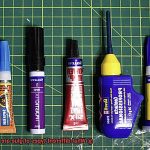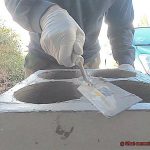Ever been in a sticky situation where you needed to stick plastic to rubber? Whether you’re tackling a DIY project or just need a quick fix, combining these two materials can feel like solving a puzzle.
In this blog post, we’ll explore all the nifty methods you can use to make plastic and rubber stick together like glue.
From specialized adhesives to out-of-the-box bonding techniques, we’re delving into the world of sticking plastic and rubber.
So if you’ve ever wondered how to create a bond that’s as strong as superglue between these materials, keep reading – we’ve got the answers.
What is Plastic and Rubber?
Contents
In the realm of materials, plastic and rubber reign supreme, each possessing unique properties that make them indispensable in various industries. Understanding what makes these materials tick is essential when it comes to answering the question: “What is plastic and rubber?”
In this captivating exploration, we will delve into the fascinating world of plastic and rubber, uncovering their secrets and shedding light on their applications.
Plastic: A Symphony of Versatility
Plastic, born from a symphony of polymers, is a synthetic material that has revolutionized the modern world. From its lightweight nature to its remarkable durability, plastic possesses an astonishing array of traits.
Not bound by convention, it can be molded into any shape or form, making it adaptable for countless applications. Whether it’s the flexible polyethylene (PE), the robust polypropylene (PP), or the versatile polyvinyl chloride (PVC), each type of plastic showcases its own distinctive qualities.
Rubber: The Elastic Enigma
Rubber, on the other hand, is an enigma of elasticity. Derived from the sap of rubber trees or created synthetically through complex chemical processes, rubber exhibits resilience and flexibility that defy expectations.
Its ability to withstand abrasion, heat, and chemicals makes it invaluable in numerous industries. From tires that grip the road with tenacity to seals and gaskets that ensure watertight security, rubber’s contributions are ever-present and far-reaching.
The Bonding Dance: Adhesives for Plastic and Rubber
The perfect union between plastic and rubber requires the right adhesive as the conductor of this bonding dance. Let’s explore various types of adhesives that can seamlessly bring these materials together:
- Cyanoacrylate (Super Glue): Ideal for small projects or quick repairs, super glue forms a strong bond swiftly. However, its rigidity may not be suitable for applications requiring flexibility or exposure to harsh conditions.
- Epoxy: Renowned for its strength and versatility, epoxy is a two-component adhesive that melds plastic and rubber with robustness. Although it takes longer to cure than other adhesives, its endurance against indoor and outdoor conditions is unparalleled.
- Silicone: With excellent flexibility and resistance to moisture, heat, and chemicals, silicone adhesives become the champions of bonding rubber gaskets or seals to plastic surfaces. Their ability to withstand extreme temperatures makes them indispensable in various applications.
- Polyurethane: Armed with strength, flexibility, and resistance to impact and vibrations, polyurethane adhesives forge bonds between plastic and rubber that can withstand the harshest of elements. Water and chemical resistance further enhance their prowess in outdoor environments.
- Contact Cement: The instant bonding prowess of contact cement makes it a popular choice for attaching rubber trim to plastic surfaces or bonding rubber soles to shoes. Its flexibility and heat resistance ensure a reliable connection in diverse settings.
Advantages of Bonding Plastic and Rubber
Plastic and rubber materials are often considered the dynamic duo of the material world due to their unique properties. When these two materials are bonded together using adhesives, the resulting combination offers a multitude of advantages.
In this article, we will explore these advantages in detail, shedding light on why bonding plastic and rubber is a preferred choice for many applications.
Enhanced Strength:
One of the significant advantages of bonding plastic and rubber is the enhanced strength it provides.
By creating a strong adhesive bond between the two materials, the resulting joint becomes more durable and resistant to external forces such as tension, compression, and shear.
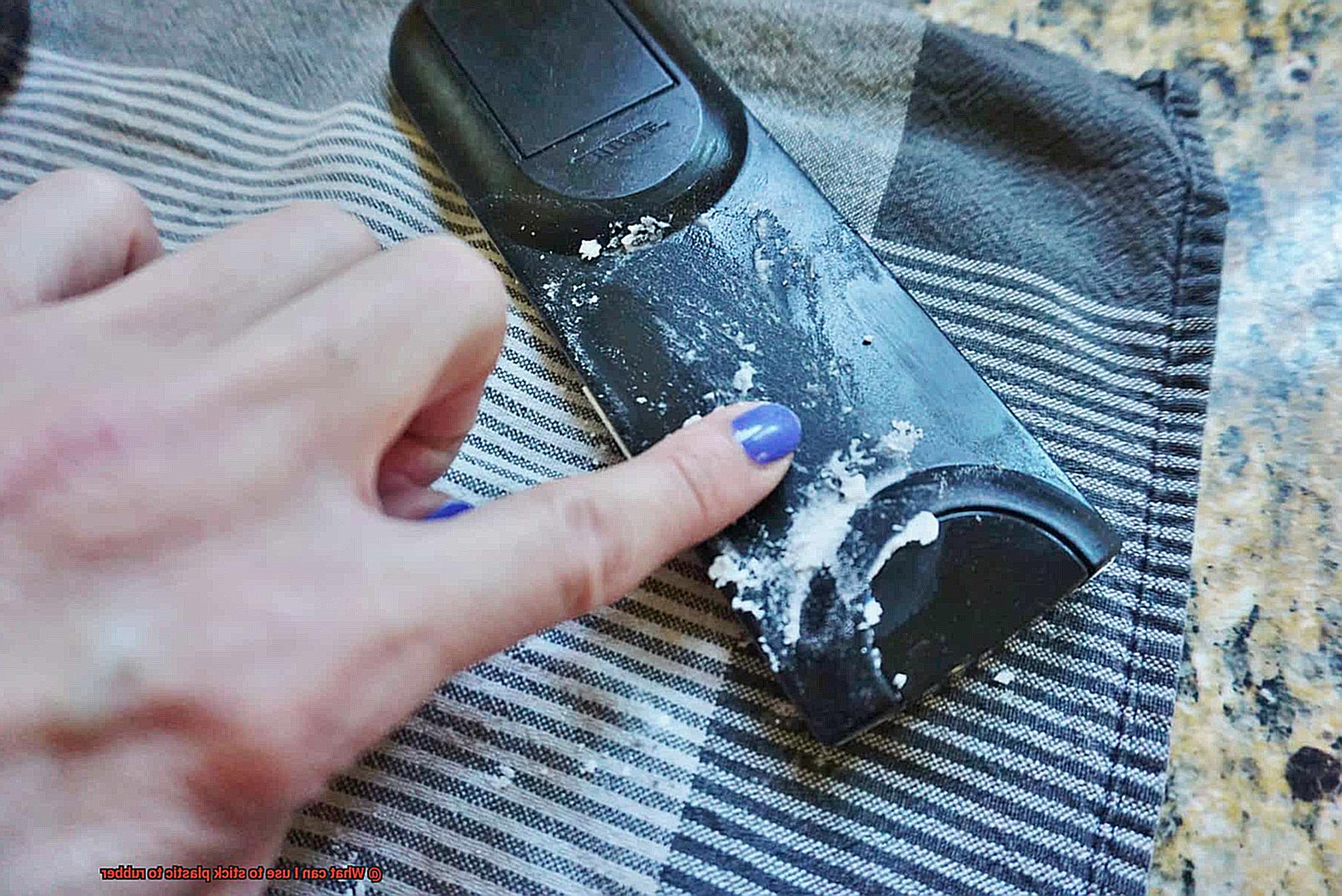
This makes it ideal for applications that involve heavy loads or mechanical stress.
Increased Flexibility:
The combination of plastic and rubber offers increased flexibility in terms of design and functionality. Plastic components provide rigidity and structural support, while rubber components offer elasticity and shock absorption properties.
By bonding these materials together, manufacturers can create products that are both sturdy and flexible, making them suitable for a wide range of applications such as automotive parts, electronic devices, and sports equipment.

Improved Sealing Capabilities:
Bonding plastic and rubber can provide excellent sealing capabilities, making it an ideal choice for applications that require air-tightness or water-tightness. The adhesive bond not only prevents leaks but also ensures a secure seal between the two materials, reducing the risk of contamination or damage caused by external elements.
This advantage is particularly important in industries such as aerospace, automotive, and medical, where maintaining a controlled environment is crucial.
Chemical Resistance:
Plastic and rubber materials can be vulnerable to degradation when exposed to certain chemicals or solvents. However, by bonding them together using appropriate adhesives, the resulting joint can exhibit improved resistance to chemical substances.
This advantage allows manufacturers to use plastic-rubber bonded components in environments where exposure to aggressive chemicals is common without compromising the integrity of the materials.
Cost-effective Solution:
Bonding plastic and rubber can be a cost-effective alternative to other joining methods such as mechanical fastening or welding. Adhesive bonding eliminates the need for additional hardware or specialized equipment, reducing manufacturing costs and simplifying assembly processes.
Moreover, the use of adhesives provides a more uniform distribution of stress across the joint, minimizing the risk of localized stress concentrations that can lead to premature failure.
Versatility in Design:
The ability to bond plastic and rubber opens up a world of possibilities in terms of design flexibility. Manufacturers can create complex shapes, intricate patterns, and customized components by combining different types of plastics and rubbers.
This versatility allows for innovative product designs that meet specific requirements in various industries, including electronics, consumer goods, and medical devices.
Commonly Used Adhesives for Bonding Plastic to Rubber
Bonding plastic to rubber may seem like a daunting task, but fear not. We have delved into the fascinating world of adhesives to bring you the commonly used ones for this purpose. Think of it as uncovering a secret recipe that will unlock the perfect harmony between these two materials.
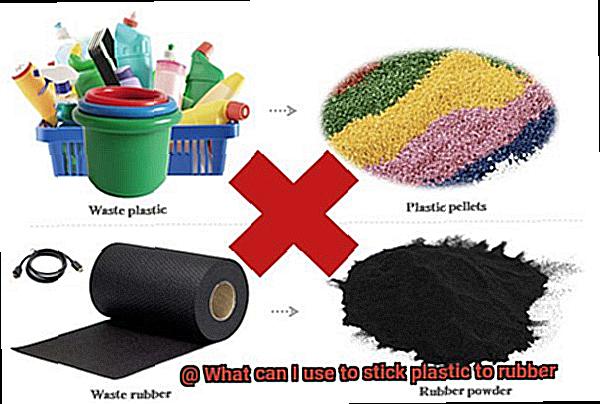
First on our list is cyanoacrylate adhesive, also known as super glue. This adhesive is like a superhero in the bonding world, with its lightning-fast curing time and incredible strength.
It forms a chemical reaction with the moisture in the air, creating a bond that can withstand even the toughest challenges. However, not all plastics and rubbers are compatible with cyanoacrylate adhesive, so testing it on a small area is crucial.
Next up is epoxy resin, a dynamic duo of a two-part adhesive. When the resin and hardener are combined, they undergo a magical chemical reaction, transforming into an unbreakable bond. Epoxy resin boasts excellent adhesion properties and can handle a wide range of plastics and rubbers. Just follow the manufacturer’s instructions and ensure proper surface preparation for this powerful adhesive.
If flexibility is what you’re after, look no further than polyurethane adhesive.
This adhesive is like a skilled yoga master, effortlessly accommodating movement and vibration. Its strong bond can withstand temperature changes and moisture, making it perfect for challenging environments. Whether in liquid or paste form, polyurethane adhesive offers various application methods.
But hold on tight, because some plastics and rubbers require specialized adhesives tailored just for them. Silicone rubber, for example, has low surface energy and can be tricky to bond. That’s where specialized adhesives formulated specifically for silicone rubber come to the rescue.
These adhesives often require specific surface preparation techniques, such as primers or surface activators, to ensure a strong bond.
When choosing an adhesive, consider the specific requirements of your application.
Factors like bond strength, flexibility, temperature resistance, and environmental conditions all play a role. And don’t forget to consult the manufacturer’s guidelines and conduct a small-scale test before committing fully.
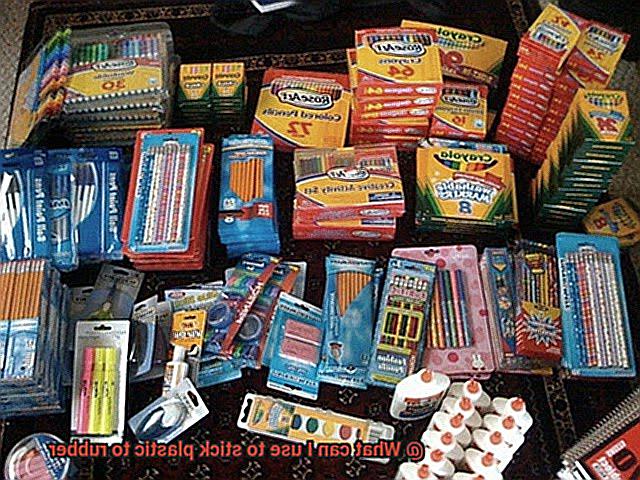
Cyanoacrylate (Super Glue)
In the realm of adhesive wonders, there exists a substance that possesses a mystical ability to forge an unbreakable bond between plastic and rubber surfaces. Its name? Cyanoacrylate, more famously known as super glue. Prepare to be captivated as we delve into the realm of this extraordinary adhesive, exploring its uses, potential hazards, and the secrets to harnessing its power.
Chapter 1: The Marvelous Chemistry
Step into the world of cyanoacrylate, where magic unfolds through the chemical reactions it performs. Super glue works by reacting with moisture in the air, causing it to harden and form an incredibly strong bond. When applied to plastic and rubber surfaces, it swiftly adheres, creating a connection that defies all odds.
Chapter 2: Secrets of Success – Preparing for the Bond
Before embarking on your bonding adventure, you must prepare the surfaces for this remarkable union. A meticulous cleansing ritual is necessary, banishing any trace of dirt, dust, or grease that could sabotage the bond. Armed with a clean cloth and gentle detergent, wipe away all impurities to ensure a pristine environment for the magic to unfold.
Chapter 3: Mastering Application – Less is More
The art of applying super glue requires finesse and precision. Remember, dear reader, that less is more when it comes to this formidable adhesive. A modest amount is all it takes to weave the web of connection. Applying too much risks overflow and seepage, which could compromise the bond. Use your steady hand to apply the glue sparingly where needed, ensuring equal coverage.
Chapter 4: The Dance of Curing Time
Patience is a virtue when it comes to witnessing the full potential of super glue. Though it dries in mere seconds or minutes, allowing the adhesive to fully cure before subjecting it to stress or load is paramount. This waiting game ensures a bond that is not only strong but also enduring.
Chapter 5: Compatibility – The Matchmaker’s Dilemma
As with all great love stories, compatibility plays a vital role. Super glue may boast its prowess in bonding plastic and rubber, but not all plastics and rubbers are created equal. Some possess low surface energy, rendering them resistant to the charm of super glue. Fear not, dear reader, for there exist other adhesives specifically formulated for these materials. Seek out the perfect match for optimal results.
Chapter 6: A Dance with Danger – Safety First.
In the realm of powerful adhesives, safety reigns supreme. Prepare your workspace with care, ensuring proper ventilation and minimizing the risk of direct contact with skin or eyes. Should fate intervene and accidental contact occur, fear not. Swiftly rinse with copious amounts of water and seek medical attention if necessary. Safety is the guardian that protects us all.
Epoxy
Today, we dive into the captivating realm of epoxy adhesive, a magical potion that defies separation and brings together plastic and rubber in an unbreakable bond. So, gather your materials and prepare to be spellbound by the power of epoxy.
Step 1: Preparing the Surfaces
To ensure a successful union between plastic and rubber, proper surface preparation is key. Begin by cleansing both surfaces with a mild detergent solution, banishing any dirt, grease, or contaminants. A clean slate sets the stage for a flawless bond.
Step 2: A Touch of Roughness
Enhancing adhesion requires a gentle touch. Skillfully roughen the surfaces with fine-grit sandpaper, creating a slightly textured canvas without causing harm. We seek a connection that’s strong yet gentle, like the caress of a gentle breeze.
Step 3: The Art of Mixing
Now it’s time to unleash the magic within epoxy adhesive. Follow the instructions provided by the manufacturer to mix the resin and hardener in their correct proportions. With precise measurements and a steady hand, you’ll concoct a potion that guarantees an unyielding bond – a secret recipe handed down through generations of craftsmen.
Step 4: Applying with Finesse
With brush or applicator in hand, apply the mixed epoxy onto one of the prepared surfaces. Spread it with care, ensuring every nook and cranny is coated. For optimal effectiveness, apply just enough adhesive to coat without excess dripping – remember, less is often more. Like an artist delicately painting on a canvas, every stroke must serve a purpose.
Step 5: The Perfect Union
Press the plastic and rubber surfaces firmly together like two long-lost friends reuniting after years apart. To keep them in place during the curing process, consider using clamps or other securing methods. Patience becomes our ally as we wait for the epoxy to work its magic. Time stands still as the bond strengthens, sealing their fates together.
Step 6: The Final Act
As the final chapter of our magical journey unfolds, allow the epoxy adhesive to cure fully. Refer to the instructions provided by the manufacturer for guidance on curing time. Remember, different epoxies have distinct personalities – some may cure quickly, while others prefer a leisurely pace. A little patience goes a long way, as the bond solidifies and becomes one.
Silicone
Silicone, a versatile adhesive that can work wonders in bonding plastic to rubber, is a game-changer in the world of adhesives. This remarkable substance is known for its strong adhesion and flexibility, making it the perfect choice for this type of application.
Silicone adhesive comes in various forms, including liquid, gel, and caulk. Each form has its own advantages and is suitable for different types of projects. Liquid silicone adhesive is often used for bonding small surfaces or intricate parts, while gel and caulk forms are more suitable for larger surface areas. So, no matter what size your project is, there’s a silicone adhesive that will suit your needs.
One of the key properties of silicone adhesive is its ability to adhere to a wide range of materials, including plastic and rubber. This makes it a popular choice for bonding these two materials together. Silicone adhesive forms a strong and durable bond that can withstand various environmental conditions, such as temperature fluctuations and moisture exposure. You can trust that once you’ve bonded plastic to rubber with silicone adhesive, it’s not going anywhere.
Before you start applying the adhesive, it’s crucial to properly clean and prepare the surfaces to be bonded. This means removing any dirt, oil, or other contaminants that may hinder the adhesive’s ability to bond effectively. You can also roughen the surfaces with sandpaper or a similar abrasive material to enhance the bond strength.
When it comes time to apply the silicone adhesive, it’s as easy as pie. Simply dispense it from a tube or cartridge using a caulking gun or similar tool. Apply the adhesive evenly onto one surface, ensuring full coverage. Then, press the two surfaces together firmly and hold them in place until the adhesive cures. The curing time may vary depending on the specific product used, so be sure to follow the manufacturer’s instructions.
While silicone adhesive is a fantastic choice for bonding plastic to rubber, it’s important to note that it may not be suitable for all types of plastic and rubber. Some plastics, such as polypropylene and polyethylene, require special surface treatments or alternative adhesives due to their low surface energy. Additionally, certain types of rubber may not bond well with silicone adhesive due to their composition or surface properties. So, always check the compatibility before diving in.
If silicone adhesive doesn’t float your boat or isn’t suitable for your project, fear not. There are alternative adhesives that can also bond plastic to rubber. Epoxy adhesives, cyanoacrylate (super glue), and polyurethane adhesives are just a few options to consider. Each adhesive has its own set of advantages and limitations, so make sure to choose the one that best suits your project requirements.
Polyurethane
Polyurethane is more than just an adhesive for bonding plastic to rubber – it’s a versatile polymer that offers excellent adhesion properties and impressive resistance to heat, moisture, and chemicals. Whether you’re working on an automotive project, construction job, or manufacturing endeavor, polyurethane adhesive is your go-to choice for achieving a strong and durable bond.
To ensure success with polyurethane adhesive, proper surface preparation is key. Cleanliness is crucial, so make sure both the plastic and rubber surfaces are free from any dirt, grease, or oil. A quick wipe with a suitable solvent or cleaner will do the trick and pave the way for optimal adhesion.
Now it’s time to apply the adhesive. Grab a brush or spatula and spread the polyurethane adhesive evenly onto both surfaces. Don’t hold back – cover the entire surface area for maximum bonding strength. If you’re working on a larger area, consider using a notched trowel to ensure an even application.
Once the adhesive has been applied, it’s time to bring the surfaces together. Press them firmly to establish good contact between the adhesive and the surfaces. Depending on the size and weight of the objects being bonded, you may need to rely on clamps or weights to hold them in place during curing.
Speaking of curing, patience is key here. Allow sufficient time for the polyurethane adhesive to cure and harden fully. The exact curing time can vary depending on factors like temperature and humidity, so be sure to consult the manufacturer’s instructions for your specific adhesive. Remember – resist the temptation to test the bond prematurely.
To ensure smooth sailing with your polyurethane adhesive project, here are some additional tips:
- Test the adhesive on a small, inconspicuous area before applying it to larger surfaces.
- Check compatibility with different types of plastics or rubbers beforehand.
- Keep in mind that polyurethane adhesive can expand during the curing process, so be mindful of any excess adhesive that may squeeze out and remove it before it hardens.
Contact Cement
Contact cement is a versatile adhesive that forms a strong and flexible bond between plastic and rubber materials. Unlike other glues, contact cement is applied to both surfaces being bonded and allowed to dry before they are pressed together. This unique drying process creates an instant and durable bond that can withstand variations in temperature and movement without cracking or separating.
To ensure a successful bond, it is crucial to prepare the surfaces properly. Clean both the plastic and rubber, removing any dirt, dust, or grease that may interfere with adhesion. Next, roughen the surfaces slightly with sandpaper to provide a textured surface for the adhesive to grip onto.
When applying contact cement, use a brush or roller to apply an even coat on both surfaces. Follow the manufacturer’s instructions regarding drying time, as this can vary depending on the specific brand and type of contact cement being used. Patience is key here – allowing sufficient drying time will ensure a strong and secure bond.
When it’s time to bring the surfaces together, align them carefully. Contact cement forms an instant bond that is difficult to reposition once in place. Apply firm pressure across the entire surface to ensure maximum adhesion. This will create a connection that will stand the test of time.
Here are some additional tips to make your contact cement experience even better:
- Test the adhesive on a small area first to ensure compatibility and desired results.
- Check compatibility with different types of plastics and rubbers before starting your project.
- Keep an eye out for any excess adhesive that may squeeze out during curing – remove it before it hardens to maintain a clean finish.
Preparing the Surfaces for Bonding
Look no further. In this comprehensive guide, we will take you on a journey through the intricate process of preparing surfaces for bonding, harnessing the remarkable adhesive known as contact cement. Get ready to unleash the full potential of contact cement and achieve a bond that can withstand even the harshest conditions.
Step 1: The Key to Success – Cleanliness
Before diving into the bonding process, cleanliness is paramount. Picture a pristine canvas awaiting your artistic touch. Both the plastic and rubber surfaces must be absolutely spotless. Armed with a gentle detergent or soap and water solution, delicately eradicate any traces of dirt, dust, or grease that could sabotage the bonding process. Caution: steer clear of harsh chemicals or solvents that may harm these precious materials.
Step 2: Roughen Up for a Tenacious Grip
To amplify adhesion, it’s time to roughen up those surfaces. Imagine tiny hooks eagerly interlocking, creating an unyielding bond. Grab some fine-grit sandpaper and gently sculpt both the plastic and rubber, unveiling a textured landscape. This step gifts your bond an extra surge of strength by increasing surface area for the adhesive to cling onto.
Step 3: Priming the Path to Success
Some adhesive journeys require an extra boost to reach their destination. Enter primers and adhesion promoters. These mystical concoctions are specially crafted to enhance bonding between disparate materials like plastic and rubber. Follow the manufacturer’s instructions and apply these enchanting elixirs, allowing them to dry completely before taking the next leap.
Step 4: Choosing the Perfect Adhesive Companion
When it comes to bonding plastic and rubber, not all adhesives are created equal. This is a crucial decision that demands careful consideration. Your options are abundant, ranging from cyanoacrylate (super glue) to epoxy, polyurethane, and silicone-based adhesives. Each possesses its own distinctive qualities and strengths, so choose your adhesive ally wisely.
Step 5: Test, Test, Test. The Gateway to Success
Before committing to the final bond, a pilgrimage of testing is essential. A small, inconspicuous area of both plastic and rubber materials becomes your experimental playground. This test will unveil the compatibility between adhesive and materials, as well as offer a glimpse into the bonding strength that awaits. Embrace this step fervently – it is your secret weapon against any unwelcome surprises.
Step 6: The Art of Application
WyM9JtRZuvc” >
Conclusion
When it comes to sticking plastic to rubber, you might be wondering what options are available.
Luckily, there are several adhesive choices that can help you achieve a strong and durable bond between these two materials. One popular option is using cyanoacrylate adhesive, also known as super glue.
Its fast-drying formula allows for quick and easy application, making it ideal for small projects. Another effective choice is epoxy adhesive, which provides a strong and long-lasting bond.
This versatile adhesive works well on various types of plastics and rubbers. Additionally, if you’re looking for a more flexible bond, silicone-based adhesives are worth considering.
They offer excellent resistance to water and extreme temperatures, making them suitable for outdoor applications. Lastly, double-sided tapes can also be a convenient solution for attaching plastic to rubber surfaces.
These tapes provide an instant bond without the need for drying time or messy application processes.



